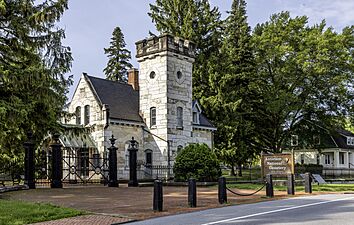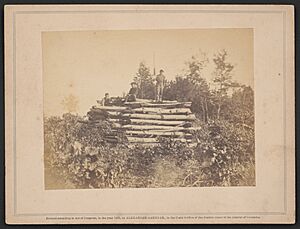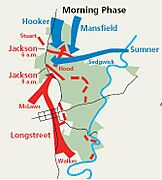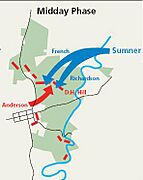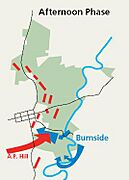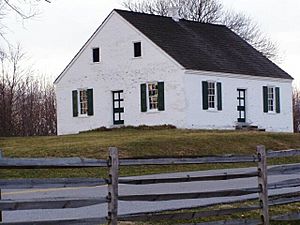Antietam National Battlefield facts for kids
Quick facts for kids Antietam National Battlefield |
|
|---|---|
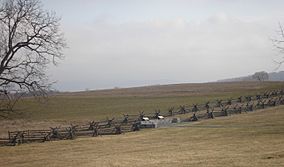
Bloody Lane at Antietam
|
|
| Location | Washington County, Maryland, U.S. |
| Nearest city | Sharpsburg, MD |
| Area | 3,229 acres (13.07 km2) |
| Established | August 30, 1890 |
| Visitors | 385,000 (in 2011) |
| Governing body | National Park Service |
| Website | Antietam National Battlefield |
|
Antietam National Battlefield
|
|
| Location | N of Sharpsburg off MD 45, Sharpsburg, Maryland |
| Built | 1862 |
| NRHP reference No. | 66000038 |
| Added to NRHP | October 15, 1966 |
The Antietam National Battlefield is a special place in Sharpsburg, Maryland. It is protected by the National Park Service. This battlefield remembers the important American Civil War Battle of Antietam. This huge battle happened on September 17, 1862.
The battlefield is located in fields near the Appalachian Mountains and the Potomac River. Here you can find the battle site, a visitor center, a national military cemetery, the famous stone arch Burnside's Bridge, and a museum about field hospitals.
Contents
Exploring Antietam Battlefield
The Battle of Antietam was a major event in 1862. It was the first time Confederate General Robert E. Lee tried to invade the North. His invasion ended right here on this battlefield.
The site became the Antietam National Battlefield Site on August 30, 1890. It was later officially named a National Battlefield on November 10, 1978. It is also listed on the National Register of Historic Places as a very important historical area.
Antietam National Cemetery: A Place of Rest
The Antietam National Cemetery is next to the battlefield. It covers about 11 acres. More than 4,976 soldiers are buried here. Sadly, 1,836 of them could not be identified.
The cemetery was created in 1865. Burials started in 1867. It was very hard to identify the soldiers' remains. Only about 40% of them were successfully identified. Only Union soldiers from the Civil War are buried here. Confederate soldiers were buried in other cemeteries nearby.
The cemetery also holds graves for veterans and their wives from other wars. These include the Spanish–American War, both World Wars, and the Korean War. The cemetery stopped new burials in 1953. However, two special exceptions were made for a congressman and a sailor.
Antietam Visitor Center: Learn About the Battle
The Antietam National Battlefield Visitor Center has many exhibits. These exhibits teach you about the Battle of Antietam and the Civil War. A 26-minute film about the battle is shown regularly.
The visitor center is open every day from 9:00 a.m. to 5:00 p.m. It is closed on Thanksgiving, Christmas, and New Year's Day. Park rangers give talks about the battle. You can also buy an audio tour for an 8.5-mile driving tour of the battlefield. The park grounds are open during daylight hours.
Pry House Field Hospital Museum: Healing the Wounded
The Pry House Field Hospital Museum is in a historic house. This house was the headquarters for Union Commander General George B. McClellan during the battle. The museum shows how doctors cared for wounded soldiers during the Civil War. It also shares information about the Pry House itself. The National Museum of Civil War Medicine helps run this museum.
Antietam Battlefield Illumination: A Candlelight Memorial
Every year, on the first Saturday in December, a special event takes place. It is called the Antietam Battlefield Illumination. This tradition started in 1989. Over a thousand volunteers place 23,000 luminaries on the battlefield.
Each luminary is a paper bag with sand and a candle. It represents one soldier who was killed, injured, or went missing during the Battle of Antietam. It is a powerful way to remember the sacrifices made.
Protecting the Battlefield for the Future
The Antietam National Battlefield was once considered one of America's Most Endangered Places. This was because there was a plan to build a shopping center on battlefield land. Many people worked together to protect this important historical site.
By 2017, the battlefield was saved. It is now a success story for preservation efforts. Groups like the American Battlefield Trust have bought and protected more land. They have helped return parts of the battlefield to how they looked during the war.
The Battle of Antietam: A Day of Fierce Fighting
The Battle of Antietam was the bloodiest single day in American history. It involved intense fighting across different parts of the battlefield.
Morning Phase: Fighting in Miller's Cornfield
The battle started at dawn on September 17, 1862. Union General Joseph Hooker began firing cannons at Confederate positions. These Confederate soldiers, led by General Stonewall Jackson, were in Miller's Cornfield. Hooker's troops then advanced and pushed the Confederates back.
Around 7 a.m., General Jackson sent more soldiers to reinforce his lines. They pushed the Union troops back. Then, Union General Joseph K. Mansfield sent his men into the fight. They managed to regain some of the lost ground.
Midday Phase: The Bloody Lane
As the fighting in the cornfield ended, Union General William H. French moved his soldiers forward. They accidentally ran into Confederate troops led by General Daniel Harvey Hill. These Confederates were positioned in a place called the Sunken Road.
Very intense fighting happened here for four hours. Finally, the Union troops managed to take control of the road. This area became known as "Bloody Lane" because of the fierce fighting.
Afternoon Phase: Crossing Burnside's Bridge
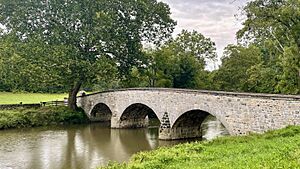
On the southeast side of town, Union General Ambrose E. Burnside's soldiers had been trying to cross Antietam Creek. They were held up for hours by only 500 Confederate sharpshooters. Around 1 p.m., they finally crossed Burnside's Bridge. They then took control of the high ground.
After a two-hour break, the Union lines advanced up the hill. They pushed the Confederates back towards Sharpsburg. If Confederate General A.P. Hill's division had not arrived just in time, Burnside's troops might have entered Sharpsburg. Instead, the Union soldiers were pushed back to the heights above the bridge.
Conclusion: The Aftermath of the Battle
The battle ended with Union forces surrounding the Confederates on three sides. Everyone waited for the next day. However, during the night of September 18, General Lee moved his troops back across the Potomac River. He left the battlefield to General McClellan.
The Battle of Antietam was the bloodiest single day in United States history. A total of 22,717 soldiers were killed, wounded, or went missing.




